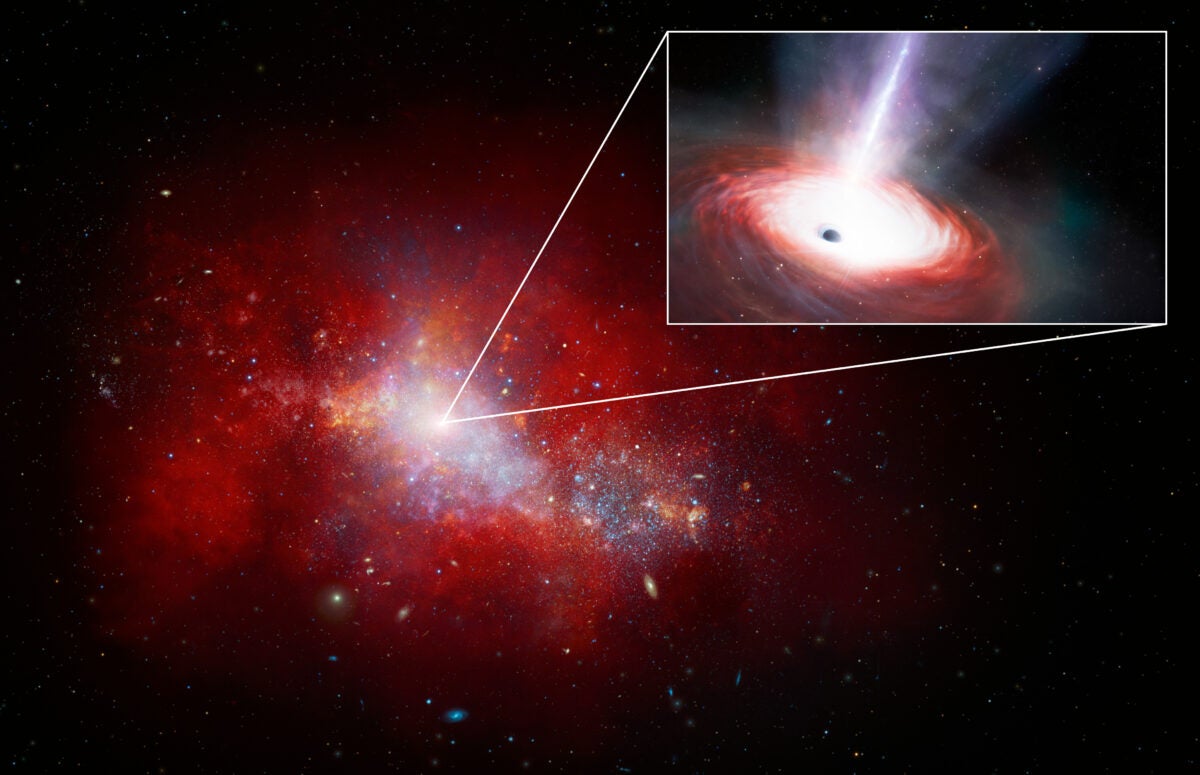The discovery offers clues to how supermassive black holes grow so big so early in cosmic time.

Blazing away inside a dwarf galaxy in the early universe, black hole LID-568 is consuming material some 40 times the theoretical limit, perhaps solving an old riddle of how supermassive black holes grow to maturity so quickly in cosmic time. Credit: NOIRLab/NSF/AURA/J. da Silva/M. Zamani
For decades, astronomers have puzzled over how the supermassive black holes residing in the center of galaxies form. Now, researchers may have found the biggest clue yet to how these monstrous objects — weighing millions of solar masses — came to exist.
An international team used the James Webb Space Telescope’s (JWST) high sensitivity to investigate a group of galaxies previously studied by the Chandra X-ray Observatory’s COSMOS legacy survey. In that data, they found a small supermassive black hole (relatively speaking), called LID-568, consuming matter faster than what the theoretical limit permits. It exists just 1.5 billion years after the Big Bang, when galaxies were just reaching maturity on the cosmic scene.
Hungry, hungry black hole
The study, published earlier this month in Nature Astronomy and led by astronomer Hyewon Suh of the International Gemini Observatory and the National Science Foundation’s NOIRLab, began by observing X-ray bright galaxies that disappear in visible and near-infrared light. But LID-568’s X-ray emission was suspiciously stronger than the others, and they couldn’t pinpoint its exact position.
JWST’s spectroscopic instruments are capable of multiple modes of observation. The most common is single-slit spectroscopy, which, as it sounds, aligns a long slit on the observing target; the light diffracts as it passes through the slit, producing a spectrum. But with LID-568’s position uncertain, this wasn’t the best choice and the team didn’t want to waste any of their observing time. So JWST’s instrumentation scientists recommended using JWST’s Near InfraRed Spectrograph (NIRSpec) in its integral field spectrography mode. This mode uses multiple long slits to collects data from each pixel in the image. This allowed astronomers to obtain spectral data not only of the very faint target, but also the even fainter surrounding area.
The observations revealed the black hole’s intense outflows of gas and allowed Suh’s team to calculate the gas’s speed and size. Their results indicate that LID-568 consumes matter more than 40 times faster than what the theoretical limit — the so-called Eddington limit — permits and that a significant portion of the system’s mass growth happened during a single, extremely rapid accretion event. “This serendipitous result added a new dimension to our understanding of the system and opened up exciting avenues for investigation,” said Suh in NOIRLab’s press release.
Race to greatness
When black hole science was still in its infancy, Sir Arthur Eddington found his way mathematically to the expression now called the Eddington luminosity or limit. It describes the maximum amount of brightness that an accreting system like a black hole can have, when the gravitational forces and outward radiation pressure are in balance. This limit on luminosity also defines the maximum rate at which black holes can accrete matter. After all, black holes only appear bright when they are actively feeding, as the turbulent material falling into their gullets heats up, lights up, and sprays outward.
But in trying to explain the existence of supermassive black holes, astronomy has a problem. We see supermassive black holes not only in our local universe, but also fairly far back in cosmic time, at times when there hasn’t been enough time for a black hole to grow so big — at least, not without breaking the Eddington limit, a law astronomers thought they understood fairly well. How does a supermassive black hole become supermassive if their accretion rate is capped, and the universe has a finite age?
LID-568 may provide an answer as it is the first direct evidence of a black hole experiencing super-Eddington accretion. Suh said that this discovery “suggests that a significant portion of mass growth can occur during a single episode of rapid feeding,” in a press release.
Astronomers have theorized about super-Eddington black holes before. They wouldn’t be stable over long periods of time, but they could explain how supermassive black holes grow so big so quickly early in the universe.
“This black hole is having a feast,” said International Gemini Observatory/NSF NOIRLab astronomer and co-author Julia Scharwächter in a press release. “This extreme case shows that a fast-feeding mechanism above the Eddington limit is one of the possible explanations for why we see these very heavy black holes so early in the Universe.”
Perhaps, in a black hole’s case, rules like the Eddington limit are made to be broken.

